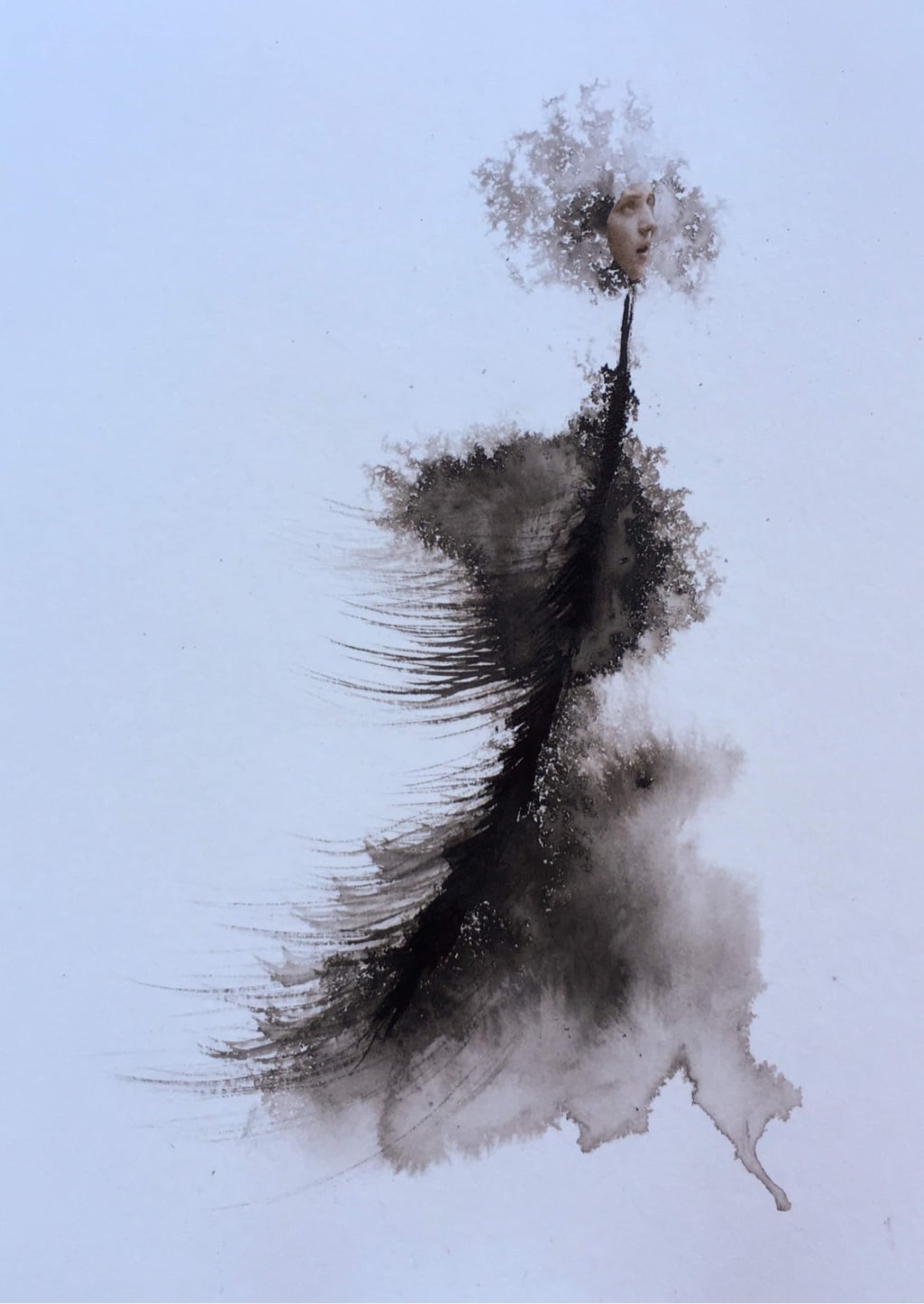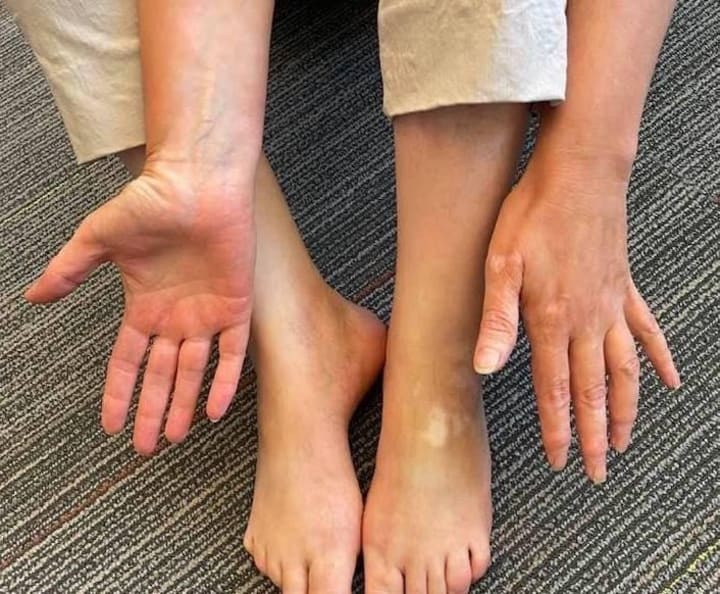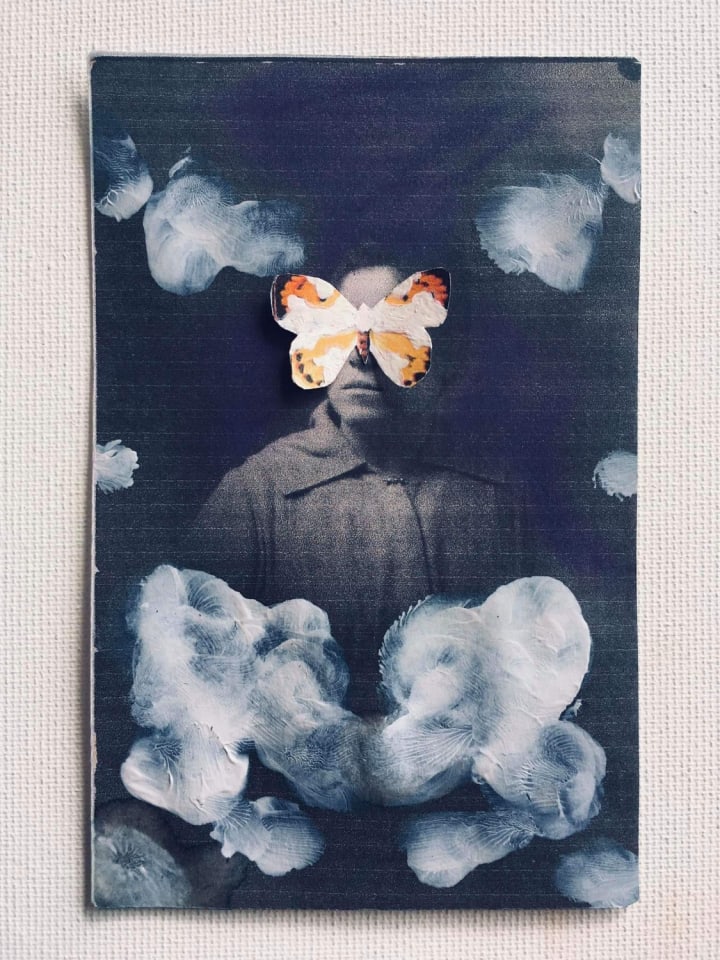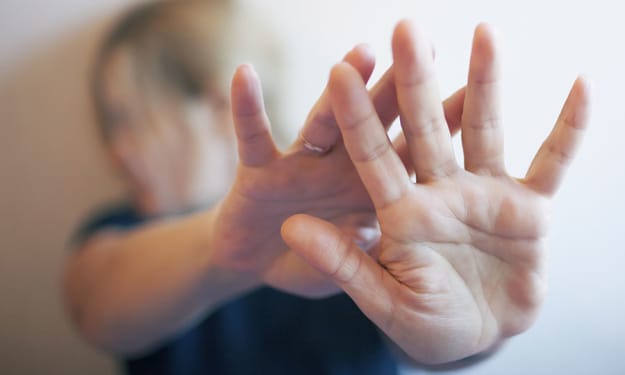My Vitiligo
Learning to Live with Something Beyond Your Control

I have Vitiligo. This beautiful name (pronounced ‘vit-ih-LIE-go’) belongs to an autoimmune skin disorder where the skin loses melanin, the color pigment. On a human body, it is manifested in white spots or blotches.
They say this disease is rare and occurs in about one in half a million people. Well, because it’s hereditary, it’s not rare in my family: My maternal grandmother had it, she said she vaguely remembered her mother having it in a mild form, a couple of my first and second cousins have it, and I have it as well. I’m carefully watching my 19-year-old son to see if he will develop it as well, but so far no signs (sigh of relief).
I discovered my first spot when I was about 12. I was on a youth volleyball team and once I was changing in the locker room when one of my teammates pointed at my belly on the left side and said, “Is that a birthmark?”
“Where?” I asked, dumbfounded. I was pretty sure I had no birthmarks in that area and was quite surprised to see a big white spot the size of a credit card, shaped like Africa. I showed it to my mother that day and she was surprised to see it as well. Apparently, that blotch literally popped up and expanded within several months.
As years passed, I got more spots on my limbs, under the eyes, around the chin and on the neck. The ones on the neck travel and may disappear and then reappear. The ones under my eyes are symmetrical. They give my eyes almost a natural non-shade. Tired people have blue circles under their eyes, I have permanent white circles. As some people say after I point them out, they make my eyes more expressive. I think they just say it to be polite or light-hearted.
My entire torso now is one big white blotch, and you can see a sharp contrast between it and the remnants of my original light-brown skin around the bikini area. I stopped wearing bikini on the beach when I was about 25, after I noticed people staring at my unevenly expanding white blotches. Also, because cancer. Lack of melanin takes away the natural skin protection against sun burns and if overexposed to UV rays, a person with Vitiligo can develop skin cancer. At 51, I often think that if more color pigment leaves my torso area, the skin on it will become translucent. By all textbooks, over 75% of my body now is covered in white blotches, which constitutes a severe case of Vitiligo. In the picture below, the area around the wrist on my right arm is as white as my entire torso. All my fingers at the top to the middle falanges are completely white as well.

But I’m white. In most cases, people don’t notice my spots until I point them out or until they’ve noticed the difference because they used to know me pretty well. Three years ago, when I traveled to my home country of Kyrgyzstan and met one of my childhood friends I had not seen for decades, one of her first questions was, “What happened to your skin? Where did all that bronze light-brown go?” That was one of the good childhood friends, whose question like this you wouldn’t consider an intrusion. So I told her about Vitiligo.
“Is it lethal?” she asked.
“Not if it does not develop into skin cancer,” I said. “No more suntanning and sunbathing for me.”
“Aww, that’s too bad,” she said empathetically and continued her inquiry, “Is it treatable?”
“Not in my case, it’s too severe now,” I said. “Years ago, when I first got to the US and only had several spots, I went to see a dermatologist. He offered me a laser treatment that would have contained the spread, but probably not reversed it.”
“Must be expensive, with the laser?” she asked.
“Yes, in 1995 it would have cost me around $5,000. Probably a lot more now.”
“Well, then forget about it. It actually makes you more beautiful,” she said cheerfully.
“How so?” I asked, teasing her.
“Makes you unique, and pale as a beautiful white flower from fairy tales.”
“I just wish I was pale all over, evenly. Not spotted white,” I sighed.
But again, I’m white. I have it relatively easy. Imagine bleached spots on dark brown or black skin. It would make such a sharp contrast that people would definitely notice. Michael Jackson reportedly had Vitiligo, which he had inherited from his father. Because it is virtually impossible to add melanin to the skin to restore the color, and because he was in showbiz where appearance matters, Jackson decided to go to the other extreme and bleach his skin. So to those people who say that he betrayed his race by becoming white, I say, “Read up on Vitiligo and search for Google images of black people with it.” By the way, the largest number of people with Vitiligo on Earth lives in India. Perhaps for that reason India has developed the most successful natural (herbal and ointment) remedies for Vitiligo which do not reverse it, unfortunately, but at least contain it. The idea to contour Vitiligo spots with laser was first developed in India as well, as my dermatologist told me. Perhaps, one day Indians will be able to conquer this disease entirely.
When I was much younger, I was extremely conscious of my skin condition. To the point of embarrassment. I tried to cover my limbs with clothes and used a lot of makeup to cover up the spots under my eyes and on the face. I rarely met people like me outside of my family and honestly thought my skin condition was the reason why I didn’t have a boyfriend. I didn’t tell that to my mom and sister because I didn’t want to upset them and because my sister would probably just laugh it off. But my skin condition was of major concern for me. Until, that is, I met a very wise man from the Philippines through work. I don’t remember how we got to that in a conversation, but I confided in him about my Vitiligo self-consciousness and that I thought it was the reason why I had not a single steady relationship.
“Who would want to go out with a spotted girl, like a leopard?” I said bitterly.
The man laughed and said, “Nonsense. You scare the men off not with your spots, but with your smarts and wit. A lot of men are afraid of an intelligent woman. Who would want to look stupider than his girlfriend?”
His words actually made me feel better about myself. Just a little bit.
But the most memorable attitude-turning encounter for me happened in Oklahoma City. I went for an academic conference there in 2005. Between the sessions, I was sitting in a café, having herbal tea and a blueberry muffin, when I saw a woman pacing back and forth in front of a university building, clearly waiting for someone. She was absolutely gorgeous: Probably in her early 50s, with long flaming red curly hair that I suspected was given to her by some Irish ancestors, and entirely Vitiligo-blotched. She wore a sleeveless midi sundress with a deep plunging neckline. It revealed white spots on her face, neck, arms, chest, and legs so severe she looked like her red freckled skin was randomly blotched white all over, and the original red was left only in the form of contours. But oh my goodness, how much confidence she had! She was oozing self-esteem through her light but steady steps and ballerina-like posture. I could tell she was in a good mood. It was a beautiful sunny late summer day, and she happily turned her face to the sun when she stopped from pacing and looked up the sky. The sun rays danced in her pale-yellow eyebrows and long eyelashes.
I couldn’t stop staring. She was so full of life and beauty it was almost breathtaking. I think she noticed my gaze and gave me a couple of nods. Academic conferences are places where you can meet people legitimately, so I decided to strike a conversation, to make up for my gawkiness.
I came up to her and said, “I have it too.”
“Excuse me??” she said, quite surprised by such an abrupt entry. But gave me her broad sunny smile nonetheless.
“This,” I said, pointing at the spots on my wrists and under my eyes.
“Ah, Vitiligo,” she said, and nodded understandably.
“Yes,” I said. “How do you cope with it?”
“I don’t,” she said and smiled at me again. “You are still young, but one day you will understand that you don’t need to cope. People either accept you for who you are or they don’t. It’s important to be accepted and loved by people who matter in your life, and believe me they don’t look at you and think ‘Vitiligo’ every time. They just see the true you, the person inside the blotched body.”
“How about people who stare?” I asked.
“I like to think they admire my unique beauty,” the woman said. “If so, let them stare all they want. If not, they’d never come up to tell me anyway.”
We talked some more, sharing our Vitiligo experiences. She also inherited it from her Irish (!) grandmother but got the first spots much earlier, at about 5-6. We swapped a couple of stories of adolescent teasing and embarrassment. Then she saw a man coming out of the university building and said, “Here is, by the way, the person who matters in my life.”
The man who looked like a quintessential academic with his balding head, square beard and a vest-busting belly greeted us on approach, gave the woman a kiss on the forehead, took her by her arm and happily whisked her away. To this day, I regret not asking her name and contact information. I wish I could thank her for the day I started to shed my embarrassment about Vitiligo and learning to simply live with it. Without coping.

P.S. I am grateful beyond words to my great friend Cindy Kuypers for providing images for this story. Find her store, "Artichoke in Bloom," on Instagram and Etsy.
About the Creator
Lana V Lynx
Avid reader and occasional writer of satire and short fiction. For my own sanity and security, I write under a pen name. My books: Moscow Calling - 2017 and President & Psychiatrist
Enjoyed the story? Support the Creator.
Subscribe for free to receive all their stories in your feed. You could also pledge your support or give them a one-off tip, letting them know you appreciate their work.






Comments
There are no comments for this story
Be the first to respond and start the conversation.